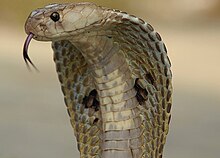Cobrais thecommon nameof variousvenomous snakes,most of which belong to the genusNaja.[1]
| Cobra | |
|---|---|

| |
| Indian cobra(Naja naja) in a defensive posture | |
| Scientific classification | |
| Kingdom: | |
| Phylum: | |
| Class: | |
| Order: | |
| Suborder: | |
| Family: | Elapidae(with some exceptions) Laurenti,1768
|
Many cobras are capable of rearing upwards and producing ahoodwhen threatened.[a]
Other snakes known as "cobras"
While the members of the genusNajaconstitute the true cobras, the namecobrais also applied to these other genera and species:
- Therinkhals,ringhals or ring-necked spitting cobra (Hemachatus haemachatus) so-called for its neck band as well as its habit of rearing upwards and producing a hood when threatened[2]
- Theking cobraor hamadryad (Ophiophagus hannah)[3]
- The two species of tree cobras, Goldie's tree cobra (Pseudohaje goldii) and the black tree cobra (Pseudohaje nigra)[4]
- The two species of shield-nosed cobras, the Cape coral snake (Aspidelaps lubricus) and theshield-nosed cobra(Aspidelaps scutatus)[4]: p.76
- The two species of black desert cobras or desert black snakes,Walterinnesia aegyptiaandWalterinnesia morgani,neither of which rears upwards and produces a hood when threatened[4]: p.65
- The eastern coral snake or American cobra (Micrurus fulvius), which also does not rear upwards and produce a hood when threatened[4]: p.30
The false water cobra (Hydrodynastes gigas) is the only "cobra" species that is not a member of the Elapidae. It does not rear upwards, produces only a slight flattening of the neck when threatened, and is only mildly venomous.[4]: p.53
Notes
- ^Two kinds of non-venomous snake, thehognose snakesand thestriped keelback,also rear upwards and produce hoods but are not considered "cobras"; likewise, some venomous elapid snakes, such as theblack mamba,are also capable of producing hoods but are not called "cobras".
References
- ^Chisholm, Hugh,ed. (1911)..Encyclopædia Britannica.Vol. 6 (11th ed.). Cambridge University Press. p. 613.
- ^Wolfgang Bücherl; Eleanor E. Buckley; Venancio Deulofeu (17 September 2013).Venomous Animals and Their Venoms: Venomous Vertebrates.Elsevier. p. 492.ISBN978-1-4832-6363-2.
- ^United States. Department of the Navy. Bureau of Medicine and Surgery (2013).Venomous Snakes of the World: A Manual for Use by U. S. Amphibious Forces.Skyhorse. p. 217.ISBN978-1-62087-623-7.
- ^abcdeMark O'Shea (20 February 2008).Venomous Snakes of the World.New Holland. p. 74.ISBN978-1-84773-086-2.[permanent dead link]
Look upcobrain Wiktionary, the free dictionary.